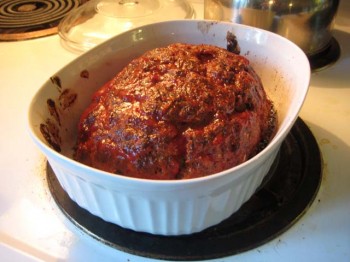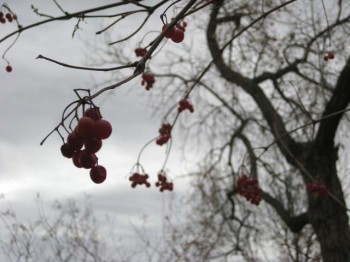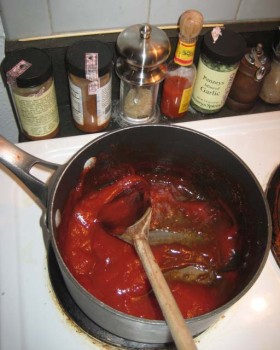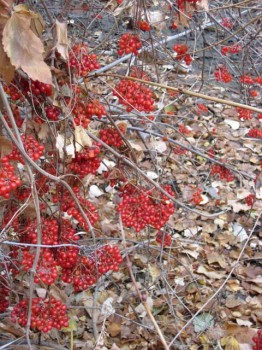
Call me a “bitter-plant apologist,” but I’m pretty pleased with myself for this, my first foray into cooking with Viburnum opulus, the highbush cranberry that is the escaped ornamental cousin of the much-celebrated native species.
Says Sam Thayer in The Forager’s Harvest (2006): “The two native highbush cranberry species, Viburnum edule and V. trilobum, are generally highly esteemed for their flavor, while the introduced European V. opulus has terrible fruit.” And this: “The European species is extremely bitter, accentuated by other bad flavors, while the native type tastes very much like cranberries. In fact, European highbush cranberries are so terrible that I don’t even consider them edible, despite the claims of some bitter-plant apologists—and frost emphatically does not improve their flavor.”
That said, my friend Butter—who coined the term “stinky sock berries” to describe the stinky, foul-tasting V. opulus— is a convert, having once discovered their abundant, ripe fruit near-glowing on its branches when most everything else nearby had turned brown with the change of seasons.

Thayer explains that European highbush cranberry is most common in the northeastern and Midwestern U.S., the Pacific Northwest, and southeastern Canada, where it is an escaped ornamental. Butter’s berries grow along an irrigation ditch in former farmland turned covenant community.
One only needs a teaspoon of her cranberry-like sauce, she told me, as we foraged some from the steep embankment of an almost-dry irrigation ditch, scaling a fence to get there. It’s good with gamey meat like venison and elk, or with liver, she said. Her recipe calls for orange juice, sugar and enough simmering to thicken the berries’ pectin-rich juices.
I would have made Butter’s version had Gregg not just picked up a container of cranberry sauce to go with our turkey dinner leftovers. And since dad has become a hunter and comes laden with venison steaks and ground venison when he visits and we happened to have some thawed venison in the fridge that needed to be eaten, here’s what I came up with:

Sock berry glaze
Ingredients:
- 1 swollen cup of sock berries
- 2 cuties (that’s what I had on hand for citrus)
- ½ cup sugar
- ½ can tomato paste
Directions:
Simmer berries briefly with a tiny bit of water and the juice of two cuties. (Thayer prefers not to boil his cranberries lest the bitter from the seeds leach into the juice, and Butter uses a food mill on the raw berries—so do what you like for this step). Mash and push through a colander to separate juice and pulp from seeds. Discard seeds; return pulpy juice to pan. Add sugar and tomato paste. Simmer and mix until heated and dissolved. Add sugar to taste.
Meatloaf
For this I just combined the ground venison with food-processed leftover bread, a dash of salad dressing to moisten (I used balsamic), ½ can tomato paste, an egg, and a sprinkle of oregano—then mixed, formed into a loaf, and baked for 35 minutes or so at 400 degrees. Then I painted the glaze onto it and returned it to the oven to bake for another 10 minutes.
It came out FABULOUS. No, really… though admittedly it’s hard to be objective with something like this. Maybe I’m just convincing myself it’s good.

However, when some of Gregg’s snowboarding colleagues came over for a meeting I pulled one aside and gave him some tastes—first of a piece of glazed loaf, then the glaze itself, and then a raw sock berry. The verdicts? Glazed meatloaf: good! Sock berry glaze: good. Raw sock berry: icky aftertaste. (For the record, Brennan was quite pleased to be offered more meatloaf after that.)
Gregg, on the other hand, was not pleased. He pulled me into the other room and told me to put that meatloaf away before everyone else got there or it would be all gone, and he wanted to eat it for dinner.
Not that I want to paint too rosy a picture of V. opulus, the European highbush cranberry. Dive into these for your first experience with edible wild plants and it’s likely you’ll find them wanting, and heaven forbid I turn an eager soul away from the sport with so putrid a berry as the wild sock—the “evil twin,” as Thayer put it, to our palatable, native wild cranberries.
NOTE 4.9.13: I’m having some cognitive dissonance here, as Linda Kershaw calls V. opulus “American bush-cranberry” in her entry on Viburnums in Edible and Medicinal Plants of the Rockies (2000), where she seems to indicate that the local native people ate this species, despite the fragrance of “dirty socks.” In Weber and Wittmann’s fourth edition of Colorado Flora: Eastern Slope (2012), however, they, like Thayer, indicate that V. opulus is a cultivated species. They also indicate that two other Viburnums–-V. lentago and V. lantana–are escaped cultivars in the Boulder area. These have different leaves than V. opulus, however, and I don’t have info on their edibility.
NOTE 4.14.13: I emailed Sam about my dilemma. He replied: “OK, some botanists separate V. opulus and V. trilobum; others consider them conspecific. They are distinctly and consistently keyable. It is not incorrect to label both species as V. opulus, but always incorrect to label the European one as V. trilobum.” Then I took another look at his book and found this additional clarifying info on V. opulus versus V. trilobum: “Some botanists even consider them the same species, which adds to the confusion and seems to have created a loophole by which many tree nurseries sell the distasteful European type labeled as the preferable American one.” He gives vegetative characteristics by which the two can be differentiated, but then says its just easier to taste the fruit. If this is the case, then I was definitely eating the gross one, however you label it–or dress it up with tomato paste and sugar, for that matter.
Updated 3.2.21

I think it was Hank Shaw who said that he believes wild food cooks in regions where there is a distinct off season are better because they are forced to be creative with the few ingredients that they have access to. It may take a forager-in-winter’s creative desperation to coax the virtues from highbush cranberries, but they are there!
Hey readers: Just in case you’re missing my weird sense of humor, the joke’s kind of on me in this entry, and certainly not on Sam Thayer, who is totally my hero and a good pen pal friend to boot. You see, the rational part of me agrees with Sam that V. opulus is gross. I am the quintessential “bitter plant apologist,” which is why I think it’s funny. Hopefully everyone can rest much easier now that we’ve cleared that up.